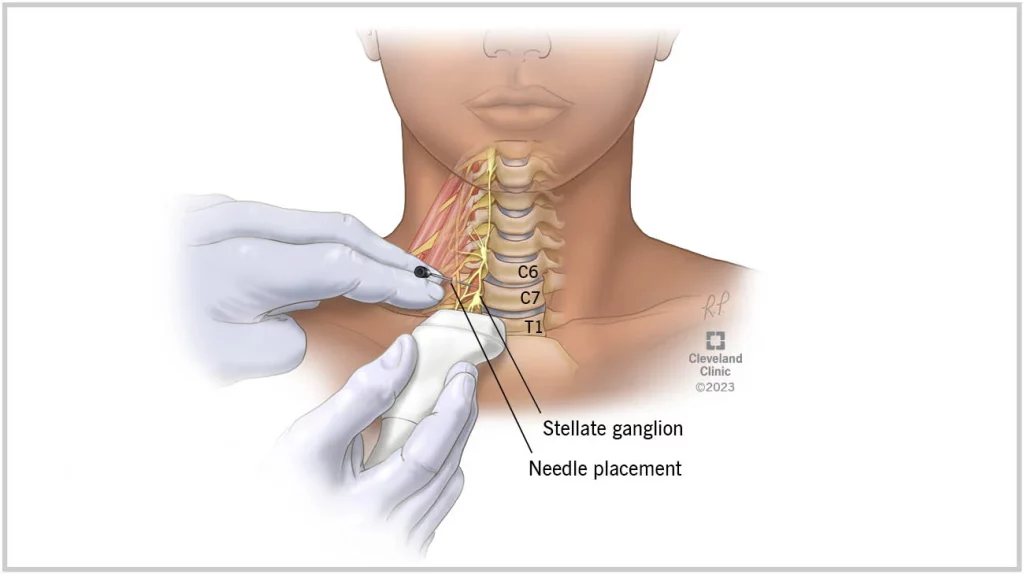Stellate Ganglion Block for Long COVID: A Potential Solution for Persistent Symptoms
Stellate Ganglion Block for Long COVID is a minimally invasive procedure that may help reduce the symptoms of long COVID, a condition that affects some people who have recovered from COVID-19 but still suffer from lingering symptoms that affect their physical and mental health.
hese symptoms may include fatigue, anxiety, depression, brain fog, pain, and inflammation. In this article, we will explain how stellate ganglion block works, what are the benefits of stellate ganglion block for long COVID patients, and what are the risks and side effects of stellate ganglion block.
What Is Stellate Ganglion Block?
Stellate ganglion block is a type of nerve block that targets the stellate ganglion, a bundle of nerves located at the base of the neck, near the collarbone. The stellate ganglion is part of the sympathetic nervous system, which controls the body’s “fight or flight” response to stress or danger.
When the brain perceives a threat, the sympathetic nervous system activates various physiological changes, such as increasing the heart rate, blood pressure, breathing, and muscle tension. These changes help the body prepare for action and cope with the stressor.
However, sometimes the sympathetic nervous system can become overactive or dysregulated, causing chronic or excessive stress, anxiety, depression, and pain. This can happen in people who have experienced trauma, such as post-traumatic stress disorder (PTSD), or who have chronic conditions, such as long COVID.
Stellate ganglion block aims to interrupt the abnormal signals from the stellate ganglion to the brain, and restore the balance of the sympathetic nervous system. By injecting an anesthetic into the stellate ganglion, the nerve block can temporarily block the transmission of pain and stress signals, and allow the brain to reset.
How Does Stellate Ganglion Block Work for Long COVID?
Stellate ganglion block (SGB) has been used for decades to treat various conditions that involve pain or dysfunction of the sympathetic nervous system, such as complex regional pain syndrome (CRPS), phantom limb pain, Raynaud’s syndrome, and migraine.

More recently, stellate ganglion block has been shown to be effective for treating PTSD, depression, and anxiety by reducing the hyperactivity of the amygdala. This brain region processes emotions and fear. Studies have found that stellate ganglion block can significantly improve the symptoms and quality of life of PTSD patients and reduce the need for medication.
SGB is performed by a trained doctor, usually an anesthesiologist or a pain specialist, in an outpatient setting. The procedure takes about 15 to 30 minutes and involves the following steps:
- The patient lies down on a table and is given a mild sedative to relax.
- The doctor uses an ultrasound or an X-ray to locate the stellate ganglion on the side of the neck.
- The doctor numbs the skin and the tissue around the stellate ganglion with a local anaesthetic.
- The doctor inserts a thin needle through the skin and the tissue and injects an anaesthetic into the stellate ganglion. The anaesthetic blocks the transmission of pain and stress signals from the stellate ganglion to the brain.
- The doctor removes the needle and applies a bandage to the injection site.
- The patient is monitored for a short time and then discharged.
The effects of SGB can be immediate or delayed, depending on the individual. Some patients may feel relief from their symptoms within minutes or hours, while others may need a few days or weeks to notice the improvement. The duration of the effects can also vary, ranging from a few weeks to several months. Some patients may need more than one SGB to achieve optimal results.
What Are the Benefits of Stellate Ganglion Block for Long COVID Patients?
SGB may offer several benefits for long COVID patients, such as:
- Increasing the blood flow to the brain may improve cognitive function, memory, and mood.
- Reducing the levels of inflammatory markers, such as C-reactive protein (CRP) and cytokines, which are associated with inflammation and tissue damage.
- Modulating the immune system function, may help the body fight off infections and heal from injuries.
- Lowering the heart rate and blood pressure, may reduce the risk of cardiovascular complications.
- Relieving pain and discomfort, may improve the quality of life and well-being.
- Decreasing anxiety and depression may enhance the emotional and mental health.
SGB may also help long COVID patients who have co-existing conditions, such as PTSD, chronic fatigue syndrome (CFS), or CRPS, by addressing the common underlying cause of sympathetic nervous system dysregulation.
What Are the Risks and Side Effects of SGB?
SGB is generally considered a safe and well-tolerated procedure, but like any medical intervention, it may have some risks and side effects. These may include:
- Bleeding, bruising, or infection at the injection site.
- Temporary drooping of the eyelid, redness of the eye, or pupil constriction on the same side as the injection. This is called Horner’s syndrome and usually resolves within a few hours or days.
- Temporary hoarseness, difficulty swallowing, or numbness of the tongue on the same side as the injection. This is due to the temporary effect of the anesthetic on the nearby nerves and muscles and usually resolves within a few hours or days.
- Temporary increase in pain or discomfort on the opposite side of the body as the injection. This is called a rebound effect and usually resolves within a few days or weeks.
- Allergic reaction to the anesthetic or the sedative. This is rare but can be serious and may require immediate medical attention.
SGB is not recommended for patients who have:
- An active infection or inflammation in the neck or chest area.
- A bleeding disorder or a low platelet count.
- An allergy to the anesthetic or the sedative.
- A history of seizures or stroke.
- A pacemaker or other implanted device in the chest.
SGB should be performed by a qualified and experienced doctor who can assess the patient’s medical history, perform a physical examination, and explain the procedure, the benefits, and the risks. The patient should also follow the doctor’s instructions before and after the procedure, such as avoiding alcohol, smoking, and certain medications, and reporting any adverse effects or concerns.
Conclusion
Stellate ganglion block is a potential solution for long COVID patients who suffer from persistent symptoms that affect their physical and mental health. SGB can help restore the balance of the sympathetic nervous system, increase blood flow to the brain, reduce inflammation and pain, and improve mood and well-being. SGB is a minimally invasive procedure that can be done in an outpatient setting, with minimal risks and side effects. SGB may also benefit long COVID patients who have co-existing conditions, such as PTSD, CFS, or CRPS. SGB should be performed by a trained and experienced doctor who can evaluate the patient’s suitability, explain the procedure, and monitor the outcomes. SGB may offer long COVID patients a new hope for recovery and relief.




